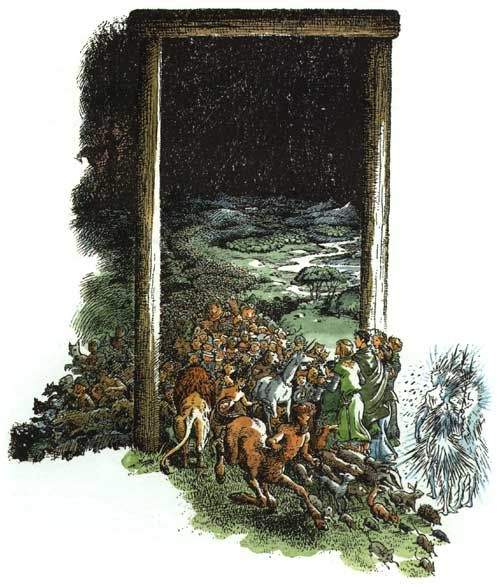
Spiritual Sunday
C. S. Lewis’s Last Battle draws heavily on the the Book of Revelation, which has been furnishing the lectionary readings for the last few Sundays. Even though I didn’t know this when I read it as a child, it still struck me as too didactic, at times more allegory than adventure. Therefore, although I enjoyed Tirian, the unicorn Jewel, and the return of Jill and Eustace from The Silver Chair, Last Battle was my least favorite of the Narnia books.
I particularly disliked Lewis going on and on about false prophets and huckster preachers, a theme that Milton harps on in Paradise Lost. Nor was I overly impressed with Aslan separating out the sheep from the goats, sending some to Narnia heaven and the rest to eternal darkness. We even get a version of climate change apocalypse:
At last something white—long, level line of whiteness that gleamed in the light of the standing stars—came moving towards them from the eastern end of the world. A widespread noise broke the silence: first a murmur, then a rumble, then a roar. And now they could see what it was that was coming, and how fast it came. It was a foaming wall of water. The sea was rising. In that treeless world you could see it very well. You could see all the rivers getting wider and the lakes getting larger, and separate lakes joining into one, and valleys turning into new lakes, and hills turning into islands, and then those islands vanishing. And the high moors to their left and the higher mountains to their right crumbled and slipped down with a roar and a splash into the mounting water; and the water came swirling up to the very threshold of the Doorway (but never passed it) so that the foam splashed about Aslan’s forefeet. All now was level water from where they stood to where the water met the sky.
So we’re supposed to find Narnia heaven as compensation for the end of the world? Such thinking has caused Christian dominionists to shrug off environmental degradation.
Compare John’s concluding vision with Lewis’s. First, Revelation:
Then the angel showed me the river of the water of life, as clear as crystal,flowing from the throne of God and of the Lamb down the middle of the great street of the city. On each side of the river stood the tree of life, bearing twelve crops of fruit, yielding its fruit every month. And the leaves of the tree are for the healing of the nations. No longer will there be any curse. The throne of God and of the Lamb will be in the city, and his servants will serve him. They will see his face, and his name will be on their foreheads. There will be no more night. They will not need the light of a lamp or the light of the sun, for the Lord God will give them light. And they will reign for ever and ever.
Lewis translates this into Narnia imagery:
It is as hard to explain how this sunlit land was different from the old Narnia, as it would be to tell you how the fruits of that country taste. Perhaps you will get some idea of it, if you think like this. You may have been in a room in which there was a window that looked out on a lovely bay of the sea or a green valley that wound away among mountains. And in the wall of that room opposite to the window there may have been a looking glass. And as you turned away from the window you suddenly caught sight of that sea or that valley, all over again, in the looking glass. And the sea in the mirror, or the valley in the mirror, were in one sense just the same as the real ones: yet at the same time they were somehow different—deeper, more wonderful, more like places in a story: in a story you have never heard but very much want to know. The difference between the old Narnia and the new Narnia was like that. The new one was a deeper country: every rock and flower and blade of grass looked as if it meant more. I can’t describe it any better than that: if you ever get there, you will know what I mean.
It was the Unicorn who summed up what everyone was feeling. He stamped his right fore-hoof on the ground and neighed and then cried:
“I have come home at last! This is my real country! I belong here. This is the land I have been looking for all my life, though I never knew it till now. The reason why we loved the old Narnia is that it sometimes looked a little like this. Bree-hee-hee! Come further up, come further in!”
The old professor from The Lion, the Witch, and the Wardrobe (Digory) notes attributes the conceptualization to Plato. Then the chronicles come to an end with Lewis promising an even greater narrative:
And as [Aslan] spoke He no longer looked to them like a lion; but the things that began to happen after that were so great and beautiful that I cannot write them. And for us this is the end of all the stories, and we can most truly say that they all lived happily ever after. But for them it was only the beginning of the real story. All their life in this world and all their adventures in Narnia had only been the cover and the title page: now at last they were beginning Chapter One of the Great Story, which no one on earth has read: which goes on for ever: in which every chapter is better than the one before.
We on earth, however, need human dramas to make our stories interesting. To have Aslan summarily dismiss all darkness from existence brings Lewis’s enchanting series to an altogether disappointing end.

